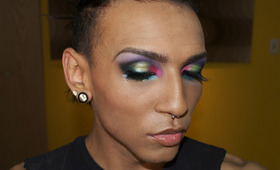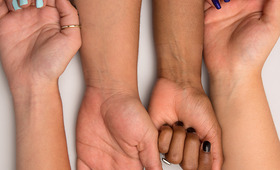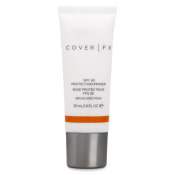Cover FX does something that few companies do so well: making truly healthy makeup accessible to the masses. Based in Toronto, Cover FX specializes in base makeup and operates out of a medical lab. The product developers work alongside a team of dermatologists (and a slew of willing test subjects) to ensure their products work on the widest range of skin tones possible—and that they’re safe for even the most sensitive wearers. Where picking the right foundation or powder can seem like a chore, Cover FX simplifies the process with an undertone-based range. There are three different foundation finishes designed to enrich the skin, none of which will clog pores. We say, it's time to kiss your incorrectly matched, irritating foundations and concealers goodbye, and say hello to clinically tested makeup that blends seamlessly with your natural coloring. We chatted with Derek Selby, Cover FX’s International Director of Artistry and Education, to find out just what goes into making these products so special.


How does the makeup industry in Canada differ from the U.S.?
The customer base in Canada is much more ingredient focused. They want to know exactly what they’re putting on their skin and into their bodies. Canadians also tend to do more research before they buy—they'll study products online and or visit a retail store to ask a ton of questions before making any purchase. They do their homework and like to investigate. This attention to detail is just starting to pick up in the United States market over the past few years.
What inspired Cover FX’s range of foundations, concealers, primers, and powders?
The central idea was to create healthy products that would perform in extreme conditions, last all day, be water-resistant, and cover a range of imperfections from dark circles and blemishes to severe acne and rosacea. All of our products are guaranteed oil-free, fragrance-free, paraben-free, gluten-free, and talc-free.
We hadn’t really considered that allergens such as gluten might lurk in our makeup.
What people often forget is that we're putting cosmetics around mucous membranes (our eyes, nose, and mouth), which means we end up ingesting them. If someone has celiac disease or a gluten intolerance, they aren't going to feel so great a couple hours into wearing cosmetics formulated with gluten. Cover FX has always been gluten-free, but what's interesting is that once we started marketing our products under that title, we had so many people come forward to thank us for creating a range of products without gluten. I'm kind of shocked at how many people are gluten-sensitive.

You develop most of the products in labs. What makes Cover FX development process so unique?
Many companies develop products in a third-party facility. Not only does Cover FX own our very own lab in Toronto, our founders come from a medical background; we work with a dermatology clinic in a hospital, so we can ensure the products are safe even for the most sensitive skin. We create our own formulas, and work with world-renowned dermatologist Dr. Neil Shear—he oversees and reviews all ingredients to verify that they’re appropriate for sensitive skin before they even enter the lab. We test new products on ourselves, and then on willing patients with skin issues. Cover FX is the only brand I know of that develops cosmetic products for patients as opposed to consumers, and operates out of a medical lab (versus a traditional cosmetics lab).
What makes your products a healthy choice for skin?
What's great about the line is, because it was developed for the most sensitive skin types, it works on everybody. As a makeup artist, no matter who's in my chair, I’m confident that our products are going to be the most gentle option on the market. We try to source products that are good for the skin—making each item a sort of hybrid of makeup and skin care. We use ingredients such as vitamins C, E and F (F, for instance, is a nourishing ingredient found in squash that hydrates without clogging pores). And we also incorporate powerful antioxidants like green tea, grapefruit extract, squalene, and lycopene. Many of the products include sunscreen, too, because protecting the skin is so important.

It's rare to see a brand address such a wide range of skin tones. How did you go about formulating shades for everyone?
Toronto is a huge cultural melting pot. There are over 100 languages spoken here. Because we have so many different ethnicities in this city, it allows us to match our makeup to actual skin tones to create the vast shade range we offer. A lot of foundation shades are developed in a cosmetics lab, and they don’t come out looking like real skin. The number one complaint from women of color is that their makeup makes their skin look ashy. This is usually because a product formulator, in an effort to make a darker tone, added black to a white-based skin shade—that leaves you with something grayish (hence the ashiness). At Cover FX, we instead balance the black with red, green, and gold to get a richer undertone that looks realistic. A popular word in beauty advertising is “exclusive,” but the root of exclusive is “exclude.” We like to refer to our range as “inclusive” because we cater to those with very fair to very dark skin and everything in between. In the end, it's not about offering a whole bunch of colors, it's about offering the right colors.
Your products are categorized by pink, gold, and neutral undertones. How do we know which is right for us?
Typically your ethnicity can help you find your undertone. For instance, people from Spanish-speaking countries as well as Asian countries tend to be more gold in undertone. Fair-skinned people from Northern Europe or Australia are often pink. But there are tons of exceptions. The best way to find out what shade works best for your is to swatch a neural shade on your skin. If it looks pink, your undertone is gold. If it looks yellow, your undertone is pink. Also, if a shade looks chalky, that means it's too light for you. If it appears muddy, it's too dark. [Check out this guide for more on finding your undertone.]

Cream, liquid, or powder foundation: Which is best for whom?
Because our formula is oil-free, all of our products perform well on a variety of skin types. In general, though, if you have oily skin, powder foundation is the best choice, because it absorbs excess oil. For dry skin, cream foundation is the most emollient. The liquid foundation can go either way, but it's ideal for normal to dry types. Amazingly, Cover FX’s powder foundation is still moisturizing, meaning many customers with dry skin have had success with it. You can also customize the finish on our products by using them with skin-smoothing primers and oil-absorbing setting powders (which can mattify a cream foundation's finish, for instance). Because our shades are identical from formula to formula, it’s not unusual for customers to switch from powder foundation in the summer to a cream base in the winter to keep their skin looking healthy as the climate changes.
What are your personal favorite picks for new customers?
One of my favorites is the Pressed Mineral Foundation. Our Chief Innovative Officer Vic Casale, the man behind MAC cosmetics and Studio FX, created the product. It's talc-free, hydrating, and provides great coverage that really looks like skin. It's quick and easy to apply, and it photographs beautifully!
Another is our Cream Concealer which inspired our tagline "Full coverage where you want it.” Most people don't need coverage everywhere, so I recommend using a light application of foundation all over, and then a little concealer just where you need it most (under the eyes, around the nose, and on blemishes). Finally, our SPF 30 Primer is a great everyday sunscreen option, but it's also completely invisible so it's great for men. It leaves no residue yet it fills in fine lines and pores, creating a smoother appearance without the look of makeup.
Featured Products
You Might Also Like
-

Makeup
Beauty Secrets from "Cupcakes and Cashmere"
- 29
-

Interviews
Spotlight On: Petrilude
- 89
-

Beauty Basics
How to Find Your Undertone and Choose the Right Foundation
- 3492
-

Interviews
How to Give Your Man a Makeover
- 22
-

Interviews
Spotlight On: Disney Prom's Yin Chang
- 14
-

Behind the Brand
Meet Pretti5—A Brand Inspired by the Founder’s Personal Skin Struggles
- 5














